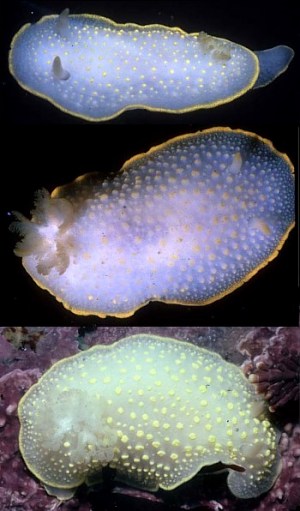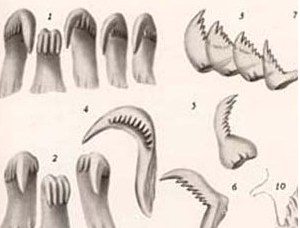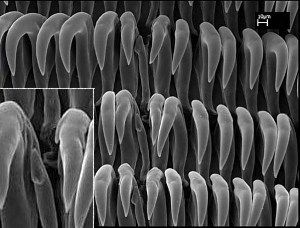The identity of Cadlina luteomarginata
August 30, 2001
From: Rebecca Johnson

Hi Bill,
I have been enjoying the discussion about Cadlina laevis and Cadlina luteomarginata. I have finally had a minute to get my thoughts and slides together. As Brian mentioned I am working on a phylogeny of basal Chromodorids including Cadlina, Cadlinella and Tyrinna. I am hoping to better understand the relationships of these groups by using morphological and molecular characters in a phylogenetic analysis. I am also planning to do some population genetic work on Cadlina luteomarginata, so this dicussion is very timely. In the UPPER RIGHT photo are some pictures I culled from the slide collection of the Californian Academy of Sciences. They are all Cadlina luteomarginata. The TOP one is from somewhere in central California. It has yellow on its gills and rhinophores and tubercles but not on the mantle glands, which are white and visible through the mantle. The MIDDLE one is from Cannery Row, Monterey, California and has yellow on its gills, rhinophores and tubercles, but the glands are not visible. The BOTTOM one is from Duxbury Reef in Marin County, California and does not have white on its gills or rhinophores and you can not see any mantle glands. (This looks a lot like Jeff's photo.)
In MacFarland's original drawing you can see the yellow on the rhinos and gills, just like in the two top animals. So, I don't know how "important" this character is ... but if it is consistent with some other characters .. then maybe we are on to something. This possibility got me thinking about some photos I took this summer with our undergraduate intern, Davi Almeida. We found variation in the radulae of Cadlina luteomarginata. I only have a photo from one specimen LOWER RIGHT (I will send more soon and I will send a reproductive drawing too!) but you can see that this rachidian differs from that described by MacFarland and illustrated at LOWER LEFT.
Unfortunately, I do not know if this specimen had yellow on its gills and rhinophores. We were looking at some older lots because they had more than one specimen, and the animals were pretty large in size (good for disection practice), but they don't include slides. This is a good example of why photos are so important even for relatively well studied species.
So, I hope someone has some insight ... or at least this will start someone thinking as the previous messages did me.
On another note, I would really like to look at the Cadlina sp. from New England. If anyone would like to send me specimens (or just a piece of the foot will work) in 95% EtOH for molecular and Bouin's or formalin fixed for morphology (the rest of the animal), along with photos I would be happy to help get to the bottom of this mystery.
Thanks and take care,
Rebecca
rjohnson@calacademy.org


Dear Rebecca,
Thanks for your thoughts. If your planning some population genetics on C. luteomarginata I would say it was pretty important to know whether you had one or two species mixed up in your populations. Since I am so far away, I am in the perfect position to make judgements on the Californian fauna. Jokes aside, if that radula in your SEM photo belongs to the Cadlina without yellow on the gills and rhinophores I would say you may have two species. As you would well know every now and then an animal has a peculiar aberrant radula, so you will need to do a few more. MacFarland's radula drawing differs not only in the shape of the central tooth but also in the shape and denticulation of the laterals. I have added some SEM photos of the radula of what I presume is C. luteomarginata which I published some time ago. They certainly look more like MacFarland's than yours, with distinctive denticulation on all the teeth, and a shorter, wider central tooth. It is certainly an interesting project and I look forward to hearing what you discover.
Best wishes,
Bill Rudman
Related messages
-
Re: Acanthodoris hudsoni or Cadlina?
From: Marli Wakeling, February 22, 2008 -
Re: Acanthodoris hudsoni or Cadlina?
From: Brian K. Penney, February 22, 2008 -
Re: Acanthodoris hudsoni or Cadlina?
From: Leslie Harris, February 22, 2008 -
Acanthodoris hudsoni or Cadlina?
From: Paul Sim, February 19, 2008 -
Re: Cadlina? Aldisa? or . Conualevia alba?
From: Brian K. Penney, August 4, 2007 -
Cadlina? Aldisa? or . Conualevia alba?
From: J. Hildering & G. Miller, August 1, 2007 -
Cadlina luteomarginata? being eaten by a seastar
From: Jackie Hildering and Glen Miller, July 10, 2007 -
Acanthodoris hudsoni or Cadlina luteomarginata?
From: Peter McGuinness, December 31, 2004 -
Cadlina luteomarginata from California
From: Bruce Wight, August 3, 2004 -
Re: Cadlina luteomarginata
From: Brian K. Penney, August 25, 2001 -
Cadlina luteomarginata from Oregon
From: Jeff Goddard, August 24, 2001 -
Dorid feeding in captivity
From: Brian K. Penney, August 24, 2001
